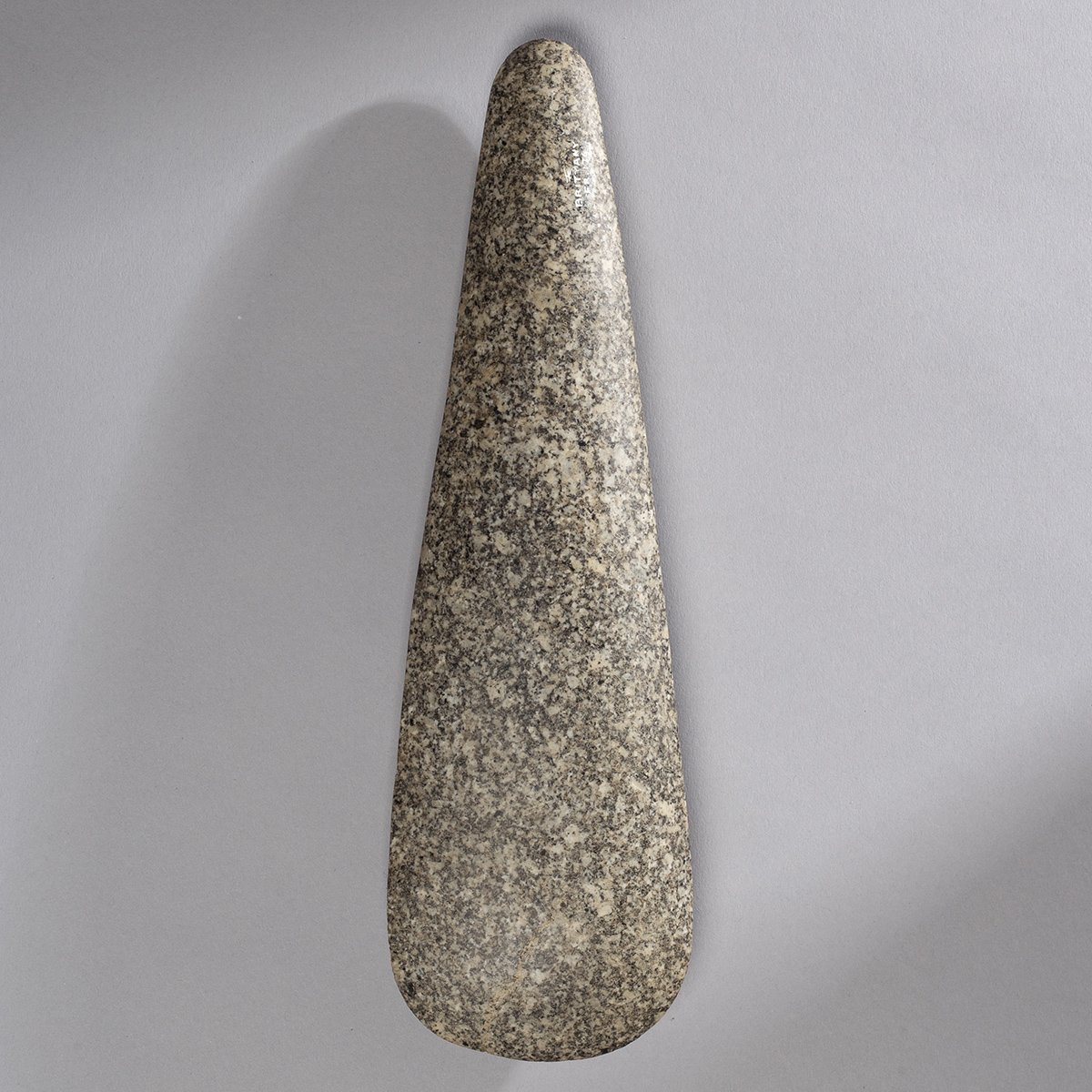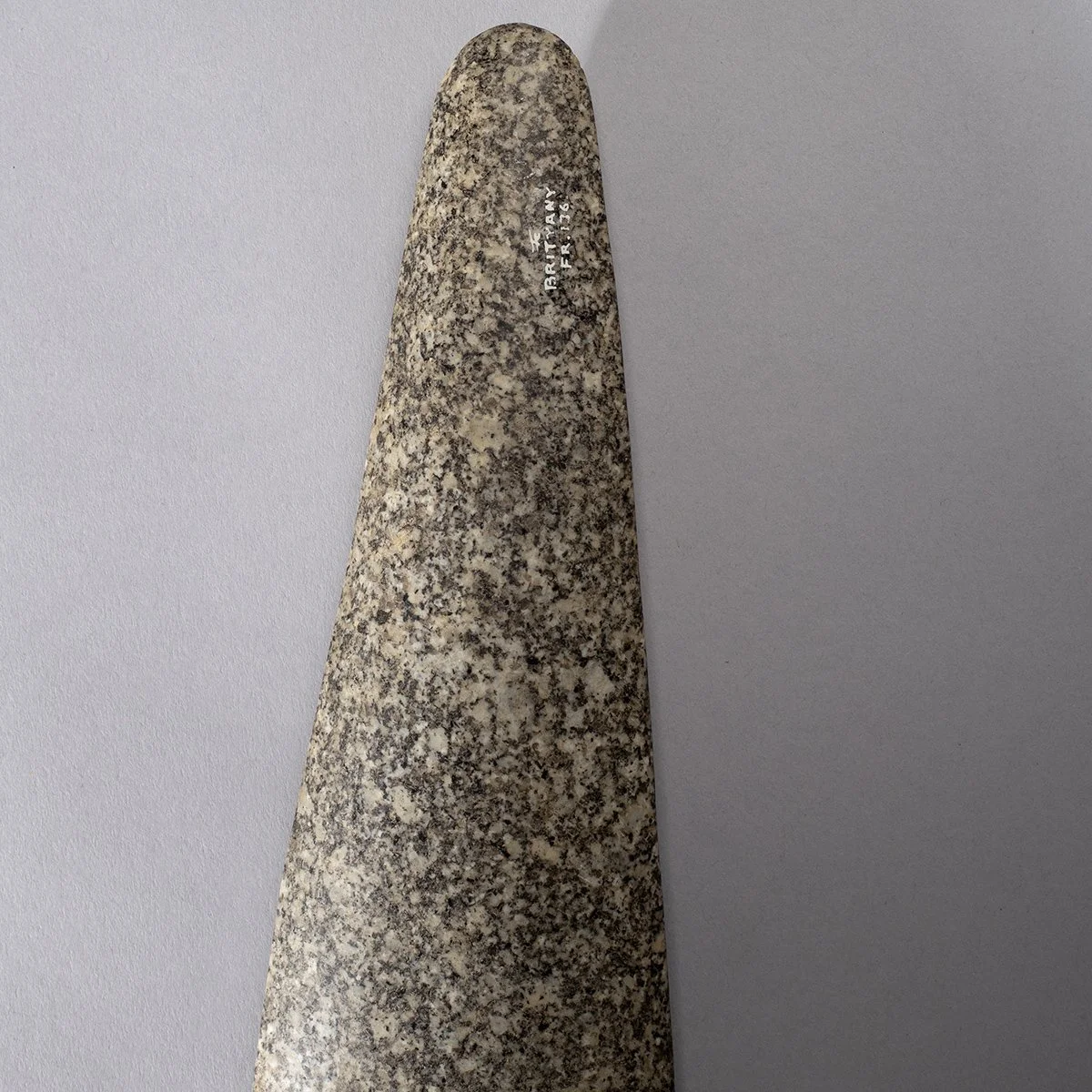 Image 1 of 4
Image 1 of 4

 Image 2 of 4
Image 2 of 4

 Image 3 of 4
Image 3 of 4

 Image 4 of 4
Image 4 of 4





Important French Neolithic Adze - SOLD
4000 - 3000 BC
Length 11 3/4" Width 3 5/8"
Provenance: Finch & Co, London
Old Museum labeling Brittany FR 176
The westernmost extensions of the Villeneuve-Saint-Germain culture, based on a Linear Pottery culture tradition are found in eastern Brittany at Le Haut Meé. The use of schistfrom the eastern edge of the Breton Massif for bracelets in settlements in the Paris Bassin attests to widespread trade. A bracelet of polished stone found in a grave in the VSG-settlement of Jablines Les-Longues-Raies was made of amphibolite from the island of Groix in southern Morbihan, proves trade with local Mesolithic communities.
The earliest long mounds date to the early-5th millennium (Barnenez). The early passage graves generally date to between 4000 and 3000 bc, followed by evolved passage graves between 3000-2500 bc. In the later part of the Neolithic, allées couvertes and simple dolmens became the predominant type of burial monument. Some passage graves are decorated with incised lines, of which Gavrinis is probably the best known example.
Some scholars see an influence of the central European Linear Pottery culture in the finds from the longbarrows of Mané Ty Ec and Mané Pochat er Ieu (Morbihan), but this should rather be connected to the la Hoguette tradition, ultimately of Cardial extraction.
Carn-pottery, thin walled round based deep bowls, often with applied crescents (croissants) is typical for early chambered tombs. It is found in Finistère, Morbihan and Loire-Atlantique.
Middle Neolithic settlements include La Motte, La Butte-aux-Pierres and Lannic. They mainly concentrate on the Coast. The pottery shows Chasséen influences. Bowls are still round-bottomed, but with s-shaped profiles and vertically perforated lugs. Some geometric decoration occurs, but is rather rare. Vase-supports of Chassey-type are found as well, the Breton variety has been named the Er Lannic type and is characterised by triangular perforations, while the examples found in the Channel Islands show circular perforations. Other local pottery types include Castellic grooved ware, Souc’h-ware, and Colpo-type ware.
Stone circles like Er Lannic (a double oval of standing stones and a ditch) sometimes contain settlement material and pottery of Chasséen-type.
By the middle of the 3rd century, the Kerugou, upper and lower Conguel and Rosmeur/Croh Collé types became preponderant.
Seine-Oise-Marne culture-influenced pottery in central Brittany includes the Quessoy and Crec’h Quille/Le Melus types. Collared bottles can be related to the Kragenflaschenhorizont of the late TBK.
From the late 3rd millennium, Grand-Pressigny flint was imported in some quantity. Some type of Breton axes were exported. For example, dolerite axes made at Plussulien have been found in Britain. The dolmen Mané-Lud at Locmariaquer is thought to show a picture of a boat.
Beaker material is known from some settlement sites, for example Kastel Koz, other beakers were found in rivers. Marine beakers predominate, AOC-decoration is found in Southern Brittany. Small gold plaques are known from beaker graves, in Kerouaren a diadem has been found.
There is no indication that the beaker people already exploited the Armorican metal deposits.
This adze made of beautiful stone and perfectly preserved may have had significant cultural or religous importance. Rare.
4000 - 3000 BC
Length 11 3/4" Width 3 5/8"
Provenance: Finch & Co, London
Old Museum labeling Brittany FR 176
The westernmost extensions of the Villeneuve-Saint-Germain culture, based on a Linear Pottery culture tradition are found in eastern Brittany at Le Haut Meé. The use of schistfrom the eastern edge of the Breton Massif for bracelets in settlements in the Paris Bassin attests to widespread trade. A bracelet of polished stone found in a grave in the VSG-settlement of Jablines Les-Longues-Raies was made of amphibolite from the island of Groix in southern Morbihan, proves trade with local Mesolithic communities.
The earliest long mounds date to the early-5th millennium (Barnenez). The early passage graves generally date to between 4000 and 3000 bc, followed by evolved passage graves between 3000-2500 bc. In the later part of the Neolithic, allées couvertes and simple dolmens became the predominant type of burial monument. Some passage graves are decorated with incised lines, of which Gavrinis is probably the best known example.
Some scholars see an influence of the central European Linear Pottery culture in the finds from the longbarrows of Mané Ty Ec and Mané Pochat er Ieu (Morbihan), but this should rather be connected to the la Hoguette tradition, ultimately of Cardial extraction.
Carn-pottery, thin walled round based deep bowls, often with applied crescents (croissants) is typical for early chambered tombs. It is found in Finistère, Morbihan and Loire-Atlantique.
Middle Neolithic settlements include La Motte, La Butte-aux-Pierres and Lannic. They mainly concentrate on the Coast. The pottery shows Chasséen influences. Bowls are still round-bottomed, but with s-shaped profiles and vertically perforated lugs. Some geometric decoration occurs, but is rather rare. Vase-supports of Chassey-type are found as well, the Breton variety has been named the Er Lannic type and is characterised by triangular perforations, while the examples found in the Channel Islands show circular perforations. Other local pottery types include Castellic grooved ware, Souc’h-ware, and Colpo-type ware.
Stone circles like Er Lannic (a double oval of standing stones and a ditch) sometimes contain settlement material and pottery of Chasséen-type.
By the middle of the 3rd century, the Kerugou, upper and lower Conguel and Rosmeur/Croh Collé types became preponderant.
Seine-Oise-Marne culture-influenced pottery in central Brittany includes the Quessoy and Crec’h Quille/Le Melus types. Collared bottles can be related to the Kragenflaschenhorizont of the late TBK.
From the late 3rd millennium, Grand-Pressigny flint was imported in some quantity. Some type of Breton axes were exported. For example, dolerite axes made at Plussulien have been found in Britain. The dolmen Mané-Lud at Locmariaquer is thought to show a picture of a boat.
Beaker material is known from some settlement sites, for example Kastel Koz, other beakers were found in rivers. Marine beakers predominate, AOC-decoration is found in Southern Brittany. Small gold plaques are known from beaker graves, in Kerouaren a diadem has been found.
There is no indication that the beaker people already exploited the Armorican metal deposits.
This adze made of beautiful stone and perfectly preserved may have had significant cultural or religous importance. Rare.
4000 - 3000 BC
Length 11 3/4" Width 3 5/8"
Provenance: Finch & Co, London
Old Museum labeling Brittany FR 176
The westernmost extensions of the Villeneuve-Saint-Germain culture, based on a Linear Pottery culture tradition are found in eastern Brittany at Le Haut Meé. The use of schistfrom the eastern edge of the Breton Massif for bracelets in settlements in the Paris Bassin attests to widespread trade. A bracelet of polished stone found in a grave in the VSG-settlement of Jablines Les-Longues-Raies was made of amphibolite from the island of Groix in southern Morbihan, proves trade with local Mesolithic communities.
The earliest long mounds date to the early-5th millennium (Barnenez). The early passage graves generally date to between 4000 and 3000 bc, followed by evolved passage graves between 3000-2500 bc. In the later part of the Neolithic, allées couvertes and simple dolmens became the predominant type of burial monument. Some passage graves are decorated with incised lines, of which Gavrinis is probably the best known example.
Some scholars see an influence of the central European Linear Pottery culture in the finds from the longbarrows of Mané Ty Ec and Mané Pochat er Ieu (Morbihan), but this should rather be connected to the la Hoguette tradition, ultimately of Cardial extraction.
Carn-pottery, thin walled round based deep bowls, often with applied crescents (croissants) is typical for early chambered tombs. It is found in Finistère, Morbihan and Loire-Atlantique.
Middle Neolithic settlements include La Motte, La Butte-aux-Pierres and Lannic. They mainly concentrate on the Coast. The pottery shows Chasséen influences. Bowls are still round-bottomed, but with s-shaped profiles and vertically perforated lugs. Some geometric decoration occurs, but is rather rare. Vase-supports of Chassey-type are found as well, the Breton variety has been named the Er Lannic type and is characterised by triangular perforations, while the examples found in the Channel Islands show circular perforations. Other local pottery types include Castellic grooved ware, Souc’h-ware, and Colpo-type ware.
Stone circles like Er Lannic (a double oval of standing stones and a ditch) sometimes contain settlement material and pottery of Chasséen-type.
By the middle of the 3rd century, the Kerugou, upper and lower Conguel and Rosmeur/Croh Collé types became preponderant.
Seine-Oise-Marne culture-influenced pottery in central Brittany includes the Quessoy and Crec’h Quille/Le Melus types. Collared bottles can be related to the Kragenflaschenhorizont of the late TBK.
From the late 3rd millennium, Grand-Pressigny flint was imported in some quantity. Some type of Breton axes were exported. For example, dolerite axes made at Plussulien have been found in Britain. The dolmen Mané-Lud at Locmariaquer is thought to show a picture of a boat.
Beaker material is known from some settlement sites, for example Kastel Koz, other beakers were found in rivers. Marine beakers predominate, AOC-decoration is found in Southern Brittany. Small gold plaques are known from beaker graves, in Kerouaren a diadem has been found.
There is no indication that the beaker people already exploited the Armorican metal deposits.
This adze made of beautiful stone and perfectly preserved may have had significant cultural or religous importance. Rare.

